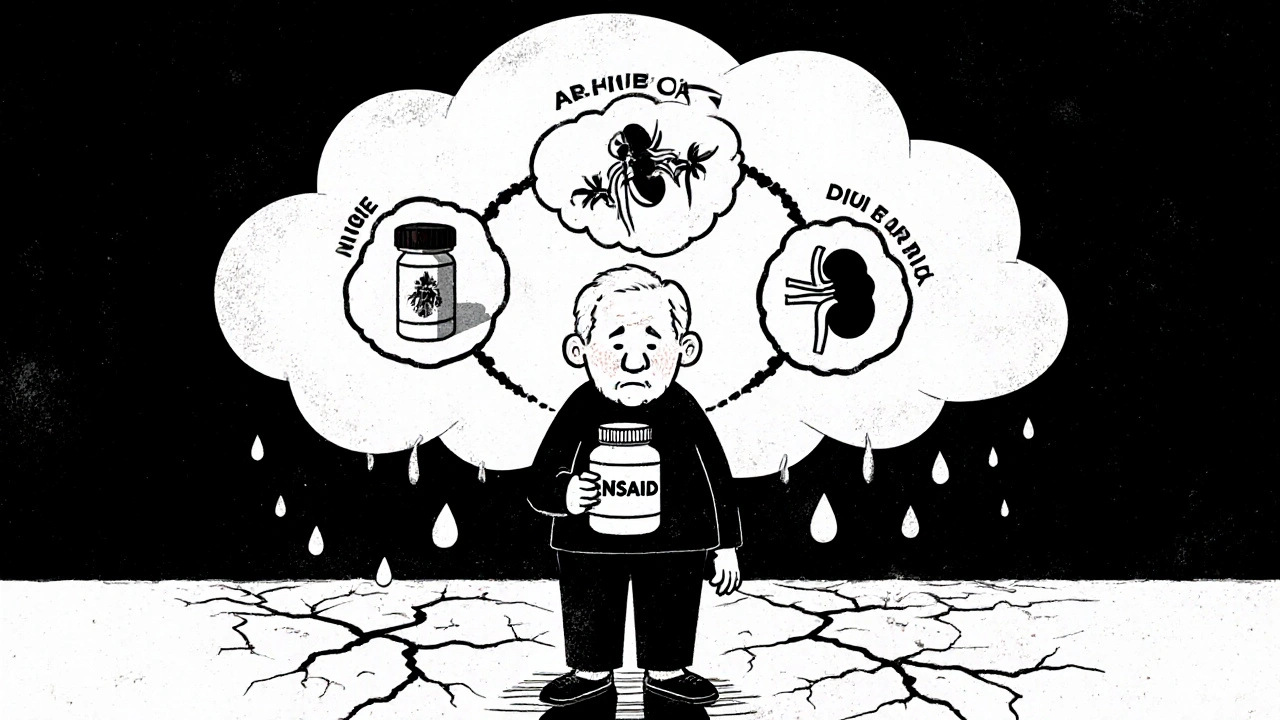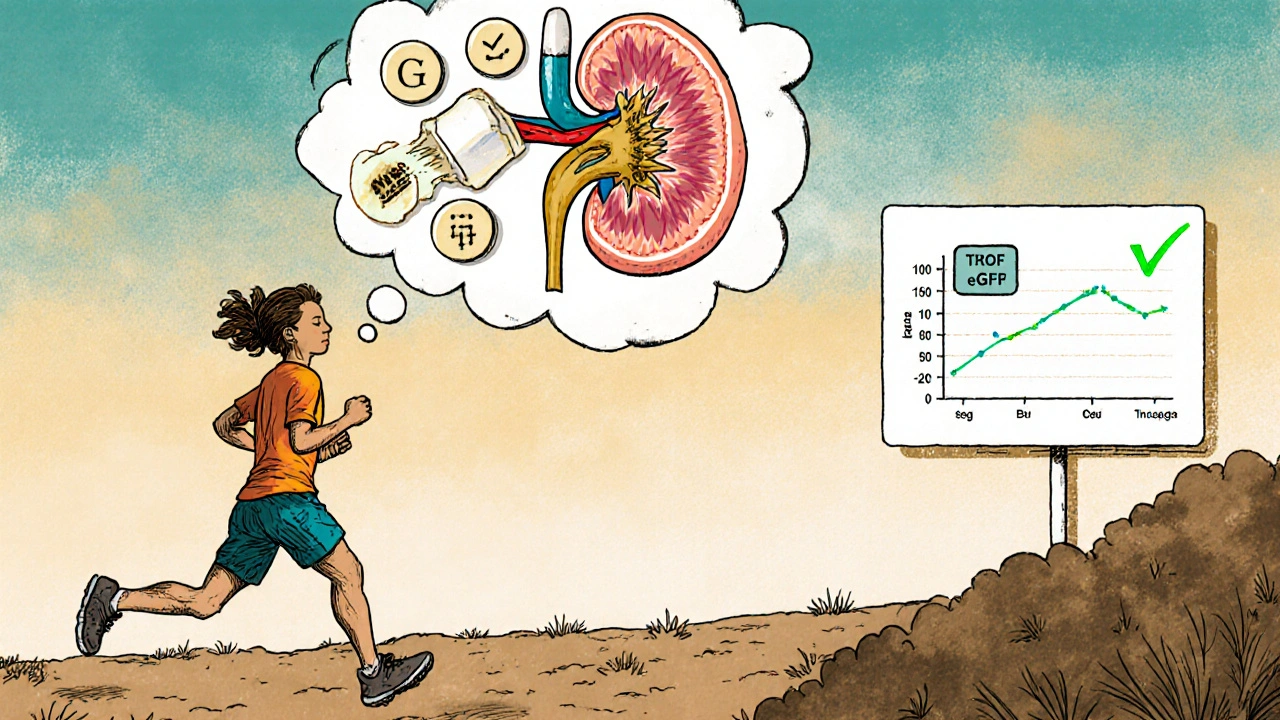NSAIDs and Kidney Disease: How to Prevent Acute Kidney Injury

NSAID Kidney Risk Calculator
How This Tool Works
This calculator estimates your 30-day risk of acute kidney injury when taking NSAIDs based on medical factors. Based on the 2023 NSAID-RF Risk Calculator used by nephrologists.
Every year, tens of thousands of people end up in the hospital not because of a heart attack or infection, but because they took something they thought was completely safe: an over-the-counter painkiller. Ibuprofen. Naproxen. Even aspirin. These drugs, known as NSAIDs, are in nearly every medicine cabinet. But for people with kidney disease-or even just slightly reduced kidney function-they can trigger a sudden, dangerous drop in kidney function called acute kidney injury.
How NSAIDs Hurt the Kidneys
NSAIDs work by blocking enzymes called COX-1 and COX-2, which help make prostaglandins. These tiny molecules aren’t just about inflammation-they’re critical for keeping blood flowing to your kidneys. When you’re dehydrated, have low blood pressure, or already have kidney damage, your kidneys rely on prostaglandins to stay alive. NSAIDs shut that safety net down.
Without prostaglandins, the blood vessels in your kidneys tighten. Blood flow drops. Glomerular filtration rate (GFR)-the measure of how well your kidneys filter waste-can fall by 20% to 40% in just 24 hours. In healthy people, this might not matter. But in someone with chronic kidney disease (CKD), diabetes, heart failure, or who’s older than 65, that drop can push the kidneys into failure.
This isn’t rare. About 1% to 5% of all acute kidney injury cases in hospitals are caused by NSAIDs. In nursing homes, where elderly patients often take NSAIDs daily for arthritis, the rate is even higher. And it’s not always obvious. Many people don’t feel sick until their creatinine levels spike-sometimes too late.
The Triple Whammy: When NSAIDs Team Up With Other Drugs
One of the most dangerous combinations is called the “triple whammy.” It happens when someone takes an NSAID along with an ACE inhibitor or ARB (common blood pressure meds) and a diuretic (water pill). Each of these drugs affects kidney blood flow in different ways. Together, they create a perfect storm.
Studies show this combo increases the risk of acute kidney injury by 31%. In the first 30 days of starting all three, the risk jumps to 82%-nearly double. Many patients don’t realize they’re on this dangerous trio. Their doctor prescribed the blood pressure pill. The diuretic helped with swelling. The ibuprofen was for back pain. No one connected the dots.
If you’re on any of these three drugs, don’t take NSAIDs without talking to your doctor. Even a single dose can be risky. There are safer alternatives for pain, like acetaminophen (Tylenol), which doesn’t affect kidney blood flow the same way.
Who’s at Highest Risk?
Not everyone who takes NSAIDs gets kidney damage. But some groups are far more vulnerable:
- People with eGFR below 60 mL/min/1.73m² (signs of early kidney disease)
- Those over 65 years old
- People with heart failure, liver disease, or diabetes
- Anyone taking diuretics, ACE inhibitors, or ARBs
- People who are dehydrated or have low blood pressure
- Those using NSAIDs daily for more than 10 days
Even if you’ve never had kidney problems, if you’re over 60 and take NSAIDs regularly, you could already have silent kidney damage. A 2023 study found that 24% of chronic NSAID users developed new-onset CKD over five years. For those already with CKD, the risk of worsening kidney function went up by 50%.

NSAID Types: Are Some Safer Than Others?
Not all NSAIDs are created equal when it comes to kidney risk.
Non-selective NSAIDs like ibuprofen, naproxen, and diclofenac block both COX-1 and COX-2. They carry the highest risk of kidney injury. Celecoxib, a COX-2 selective inhibitor, has about 20% to 30% lower risk of acute kidney injury in people with normal kidney function. But here’s the catch: that advantage disappears if your eGFR is already below 60. In people with existing kidney disease, celecoxib is just as dangerous as ibuprofen.
Topical NSAIDs-gels, creams, or patches applied to the skin-are a better option for joint or muscle pain. They deliver the drug locally with 70% to 80% less absorption into the bloodstream. A 2024 JAMA trial showed they cut kidney injury risk by nearly half compared to pills. If you have arthritis in your knees or hands, ask your doctor about a topical version.
What to Do If You’re Already Taking NSAIDs
If you’ve been taking NSAIDs for months or years, here’s what to do now:
- Get your eGFR and urine albumin-to-creatinine ratio checked. These are simple blood and urine tests. They tell you if your kidneys are already damaged.
- Review all your medications with your doctor or pharmacist. Are you on a diuretic? An ACE inhibitor? NSAIDs? If yes, you may be in the triple whammy zone.
- Switch to acetaminophen (Tylenol) for pain. It’s not anti-inflammatory, but it’s much safer for kidneys. Don’t exceed 3,000 mg per day.
- If you must use NSAIDs, use the lowest dose for the shortest time possible-no more than 7 to 10 days without reevaluation.
- Never take NSAIDs if you’re dehydrated. That includes after a long walk, during hot weather, or if you’ve had vomiting or diarrhea.
For older adults, the American Geriatrics Society says NSAIDs should be avoided entirely if eGFR is below 30. Between 30 and 60, they should only be used at the lowest dose, no more than three days a week, and only if no other option works.
Symptoms You Shouldn’t Ignore
Acute kidney injury doesn’t always cause pain. Many people feel fine until their kidneys are already failing. Watch for these signs:
- Less urine than usual-or no urine at all
- Swelling in ankles, feet, or hands
- Unexplained fatigue or weakness
- Nausea or vomiting
- Confusion or trouble concentrating
One patient in a 2020 case study took ibuprofen three times a day for back pain. He was 72, had mild kidney impairment (eGFR 58), and no symptoms. Three days later, his eGFR dropped to 22. He was hospitalized. His kidneys didn’t fully recover.

Exercise, Heat, and NSAIDs: A Hidden Danger
Many runners and athletes take NSAIDs before or after long workouts to prevent soreness. But this is risky. Exercise already reduces blood flow to the kidneys. Add NSAIDs, and you cut it even further. In hot weather, dehydration makes it worse.
Studies show NSAID use during endurance events can reduce kidney blood flow by 30% to 50% beyond what exercise alone causes. While the absolute risk is low-about 1 in 100,000 marathon runners-it’s preventable. Drink enough water. Skip the pills. If you need pain relief after a race, use ice, rest, and acetaminophen instead.
What’s New in Prevention
There’s progress on the horizon. In 2023, the American Society of Nephrology launched the NSAID-RF Risk Calculator. It uses 12 factors-age, eGFR, blood pressure, medications-to predict your 30-day risk of kidney injury with 87% accuracy. Doctors can now use it to decide whether NSAIDs are safe for you.
Researchers are also testing new drugs. One combines ibuprofen with acetylcysteine, an antioxidant that may protect kidney cells. Another approach looks at genetics. A 2025 study found that people with certain variations in the PTGS2 gene are far more likely to develop kidney injury from NSAIDs. Soon, a simple genetic test might tell you if you’re at high risk.
Early detection tools are improving too. Urine tests for NGAL (neutrophil gelatinase-associated lipocalin) can show kidney damage before creatinine rises. That means doctors could catch problems before they become emergencies.
Final Takeaway: NSAIDs Aren’t Always Safe
Just because a drug is available over the counter doesn’t mean it’s harmless. NSAIDs are powerful medicines with real, serious risks for the kidneys-especially if you’re older, have chronic disease, or take other medications. The good news? Most of these injuries are preventable.
Don’t wait until your kidneys fail to think about this. If you’re taking NSAIDs regularly, talk to your doctor. Get tested. Explore safer alternatives. Your kidneys can’t tell you they’re in trouble until it’s too late. But you can speak up for them.
Can I take ibuprofen if I have kidney disease?
If you have kidney disease, especially with an eGFR below 60, you should avoid ibuprofen and other NSAIDs unless your doctor specifically says it’s safe. Even small doses can cause sudden kidney injury. Acetaminophen (Tylenol) is a safer pain option. Always check with your doctor before taking any pain reliever.
How do I know if NSAIDs are hurting my kidneys?
You might not feel anything. The earliest sign is often a rise in serum creatinine, which shows up on a blood test. Other signs include less urine, swelling in your legs, fatigue, or nausea. If you’re on NSAIDs long-term, get your kidney function checked every 3 to 6 months-even if you feel fine.
Is naproxen safer than ibuprofen for kidneys?
No. Both naproxen and ibuprofen are non-selective NSAIDs and carry similar risks for kidney injury. Some people think naproxen is safer because it lasts longer, but that just means longer exposure. Neither is safe for people with kidney disease. Topical forms or acetaminophen are better choices.
Can I take NSAIDs if I’m dehydrated?
Never. Dehydration reduces blood flow to the kidneys. NSAIDs block the body’s natural way of compensating for that. Together, they can cause acute kidney injury in hours. If you’re sick with vomiting, diarrhea, or sweating a lot, skip NSAIDs and drink water instead.
Are topical NSAIDs safe for people with kidney disease?
Yes, topical NSAIDs (gels, creams, patches) are much safer because they enter the bloodstream in very small amounts. Studies show they reduce kidney injury risk by 40% to 50% compared to pills. They’re a good option for joint pain in people with kidney disease-but still avoid using them on large areas of skin or for long periods without medical advice.
What’s the safest pain reliever for kidney patients?
Acetaminophen (Tylenol) is the safest oral pain reliever for people with kidney disease. It doesn’t affect kidney blood flow like NSAIDs do. But don’t exceed 3,000 mg per day, and avoid it if you have severe liver disease. For localized pain, topical NSAIDs are also a good alternative.
This hit me right in the gut. My dad took ibuprofen every day for his arthritis and never knew it was slowly killing his kidneys. He got hospitalized last year and now he’s on dialysis. I wish someone had told us this before it was too late. 😢